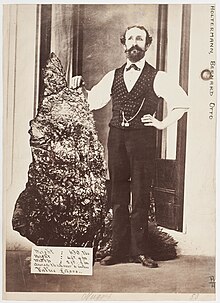Australian gold rushes: Difference between revisions
| Line 21: | Line 21: | ||
* 1849 - William Clarke junior, with William Vicary, found auriferous quartz at [[Smythesdale, Victoria]]. |
* 1849 - William Clarke junior, with William Vicary, found auriferous quartz at [[Smythesdale, Victoria]]. |
||
* [[1851 in Australia|1851]]. January - Edward Austin brought to Sydney a nugget of gold worth £35, which he found in the Bathurst District.<ref>Heaton, J.H. 1984, The Bedside Book of Colonial Doings, previously published in 1879 as 'Australian Dictionary of Dates containing the History of Australasia from 1542 to May, 1879, p.111</ref> |
* [[1851 in Australia|1851]]. January - Edward Austin brought to Sydney a nugget of gold worth £35, which he found in the Bathurst District.<ref>Heaton, J.H. 1984, The Bedside Book of Colonial Doings, previously published in 1879 as 'Australian Dictionary of Dates containing the History of Australasia from 1542 to May, 1879, p.111</ref> |
||
* [[1851 in Australia|1851]], gold was discovered in [[Warrandyte]], Victoria in the preset day State Park. |
|||
==First License== |
==First License== |
||
Revision as of 06:19, 8 March 2008

The Australian gold rushes started in 1851 when prospector Edward Hammond Hargraves proclaimed his discovery of gold near Bathurst, New South Wales, at a site Hargraves called Ophir. Six months later, gold was found in Victoria at Ballarat, and a short time later at Bendigo Creek. Gold was later found in all of the other Australian colonies (later known as states or territories).
Discoveries of gold in Australia before the rushes
Prior to Hargraves' discovery, plenty of gold had been discovered in Australia by others including Reverend WB Clarke in 1841 with further finds in 1844. When Clarke reported his discovery to the New South Wales Governor George Gipps, Gipps asked Clarke to: "Put them away, Mr Clarke, or we shall all have our throats cut!". Gold finds in a convict society were not welcomed at the time. Although the NSW and Victorian governments later rewarded Clarke for his contribution, his financial rewards didn't compare to those for Hargraves.
Other early gold finds in the colony were:
- 1814 - Some convicts who were employed cutting a road to Bathurst were rumoured to have found a quantity of gold, and were only compelled to keep silence on the point by menaces and flogging.[citation needed]
- 1823, February 15 - The first verified discovery of gold in the colonies was by Assistant Surveyor, James McBrian, who discovered gold on the Fish River, about 15 miles east of Bathurst, New South Wales.[citation needed]
- 1825 - A convict flogged in Sydney on suspicion of having stolen gold, which he stated he had discovered in the bush.
- 1839, April - Paweł Edmund Strzelecki discovered gold associated with pyrites at the Vale of Clwydd, in the Blue Mountains, New South Wales.
- 1844 - Mr Alexander Tolmein, sent by Governor Grey to Kangaroo Island to capture a gang of bushrangers, reported that he had when about 20 miles S.S.W. from Melbourne seen a quartz reef with yellow metal in it, which he was afterwards convinced was gold.
- 1848 - Gold specimens found on the spurs of the Pyrenees Mountains, Victoria; exhibited in the shop window of Mr. Robe, jeweller, Melbourne.
- 1849, January 31 - Gold discovered at the Pyrenees, Port Phillip, by a shepherd.
- 1849, January - Thomas Chapman discovered gold at Daisy Hill, Victoria and sold it to Mrs. Brentani, Collins Street, Melbourne, a nugget which weighed 16 ounces. Afraid of the Melbourne authorities, the discoverer bolted to Sydney in the 'Sea-horse'.
- 1849 - William Clarke junior, with William Vicary, found auriferous quartz at Smythesdale, Victoria.
- 1851. January - Edward Austin brought to Sydney a nugget of gold worth £35, which he found in the Bathurst District.[1]
- 1851, gold was discovered in Warrandyte, Victoria in the preset day State Park.
First License
The first license was issued in Victoria on September 21, 1851. The number of gold licenses issued in N.S.W. was 12,186, of which 2,094 were issued at the Ophir; 8,637 at the Turon; 1,009 at the Meroo and Louisa Creek; 41 at the Abercrombie; and 405 at Araluen, up to October 31, 1851.[2]

Other discoveries
- 1851 - Sofala, New South Wales
- 1865 - Richard Daintree discovered the Cape River goldfield in North Queensland.[3] Attention soon moved to Charters Towers with a more significant field discovered in 1872. The same year mining began on the Palmer River near Cooktown.
- 1872 - Darwin felt the effects of a gold rush at Pine Creek after employees of the Australian Overland Telegraph Line found gold while digging holes for telegraph poles.
Further reading
- Australian Department of Culture and Recreation: The Australian Gold Rush
- Younger, R.M. ynfghvtcf
See also
References
- ^ Heaton, J.H. 1984, The Bedside Book of Colonial Doings, previously published in 1879 as 'Australian Dictionary of Dates containing the History of Australasia from 1542 to May, 1879, p.111
- ^ Heaton, J.H. 1984, The Bedside Book of Colonial Doings, Angus and Robertson, Sydney, published in 1879 as Australian Dictionary of Dates containing the History of Australasia from 1542 to May, 1879, p.114
- ^ Sanker, Ian G. Queensland in the 1860's:The Photography of richard Daintree. Brisbane: Queensland Museum. p. 20.
{{cite book}}: Cite has empty unknown parameter:|coauthors=(help)
